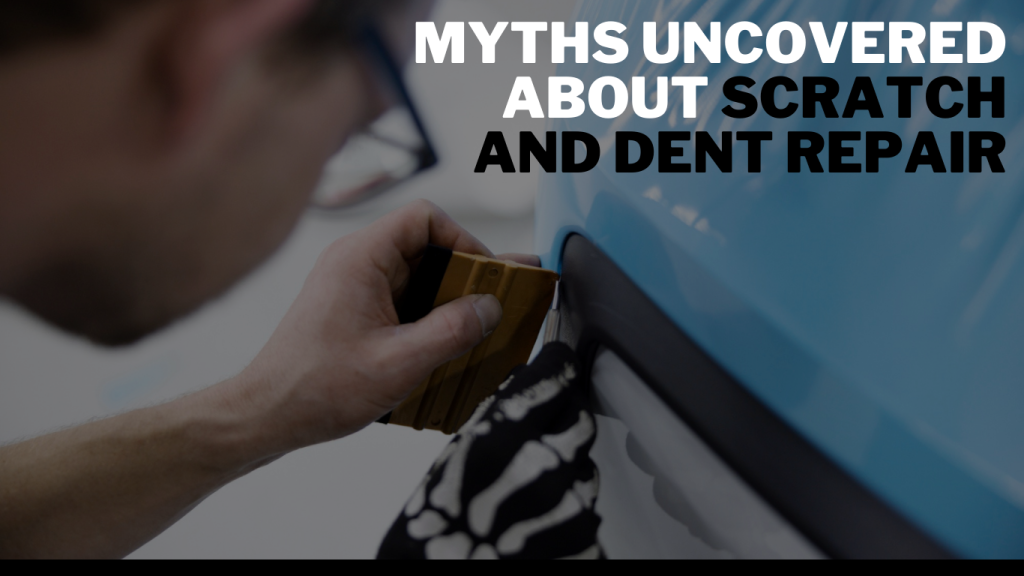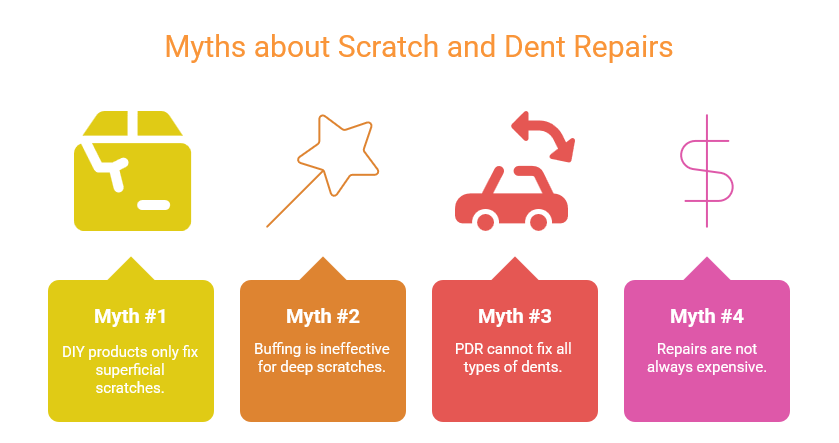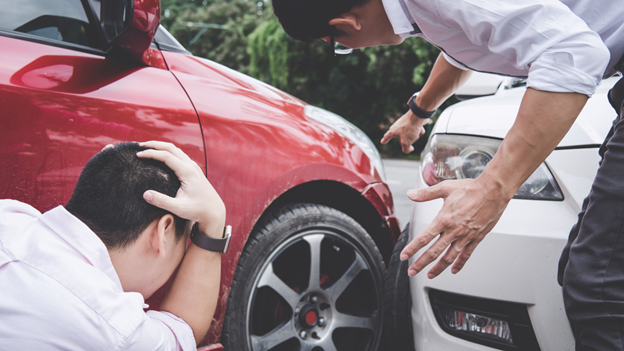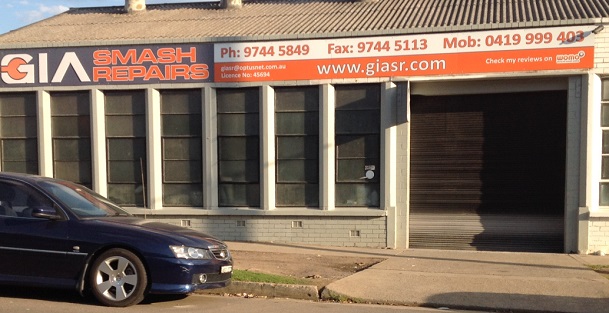
One of the most harmful misconceptions about car repair is that you don’t really need professional help. It’s not always convenient or cost-effective, especially when you can DIY the blemishes.
It happens, even to the best (drivers) of us. You’ll be faced with scratches and dents on the frame of your car. And you’ll look at the damage, thinking whether or not you need professional auto body repair. After all, it’s just a minor dent—couldn’t you handle it on your own?
However, if you want to preserve your car’s value and ensure a lasting finish, pursuing experts is essential. Let’s uncover the truth about these popular scratch and dent repair myths and the poor choices you make that could lead to bad repairs.
Common Myths About Scratch and Dent Repair
Scratch and dent repair is plagued with several myths that are tormenting the minds of vehicle owners. Due to these misconceptions, many are suffering from costly repair mistakes.
But don’t you fret, we’re here to debunk some of the biggest myths surrounding scratch and dent repair—starting with….

Myth #1: All Scratches Can Be Fixed with DIY Products
Sure, DIY scratch removers and DIY kits are good for your wallet and super convenient. But beyond the outer appeal lies their too many limitations.
These products only work with superficial scratches. Sometimes, they can even make minor imperfections worse.
Therefore, if you have deeper and more complex scratches, it’s best to let professionals deal with them. They have the experience and skill to make proper assessments and apply the right remedy.
Myth #2: Buffing Can Fix All Scratches
Buffing can smooth out scratches—as long as they’re not too deep. If the imperfection ravages under the clear coat, buffing becomes ineffective.
Furthermore, if you’re “buffing” and you do it wrong, you can inflict more damage, leaving ugly swirls and specks of discolouration. It’s best to leave buffing in the hands of experts who have the experience, skills and proper tools to perform it.
Myth #3: Paintless Dent Repair (PDR) Can Fix Any Dent
Paintless dent repair can handle shallow dents. It’s also a fantastic solution to remove larger dings.
However, if you’re dealing with more complex imperfections close to the trim of the panels, professional traditional methods are necessary.
In short, PDR can’t really fix any dent. That’s why it’s essential to have the evaluation of an expert to determine the best approach to your dent problems.
Myth #4: Scratch and Dent Repairs Are Always Expensive
Many people assume, perhaps you included, that scratch and dent repairs require a big budget. Yes, it can be costly, but it’s not always true.
From the outset, DIY repairs are attractive, cost-wise. However, doing the repairs yourself, with your little experience and non-existent repair skills, will result in more damage and a subpar finish.
Professional repairs may be expensive, but they’re a worthwhile investment in the long run. They can provide a durable, quality finish, preventing further damage and all the costly later repairs they require.
Take, for instance, PDR; it’s a professional repair solution that does not require repainting and is less laborious. So, for minor dents and scratches, PDR can be amazingly affordable.
Understanding Scratch Types and Repair Techniques
The first crucial step when repairing your car’s scratch is determining the level of damage. You can do this by feeling it out and catching the scratch using your fingernails.
Clear coat scratches do not damage the paint. It’s a normal scratch on the outer layer of the paint—nothing your DIY kit won’t fix.
On the other hand, deeper paint scratches infiltrate the clear coat and base coat and into the metal surface of your car. It’s a significant damage that needs serious repair.
Techniques for Effective Scratch Repair
Actually, you can deal with minor scratches at home. You can use a traditional polisher or an abrasive rubbing solution to get rid of the damage.
Check out these steps to “unscratch” the clear coat underneath:
1. Clean the affected area thoroughly and dry it completely.
2. Put a small amount of chemical compound on a soft cloth and apply it in a circular motion.
3. Continue rubbing the solution in the same movement until the scratch is gone.
4. Clean the affected area and dry it with a cloth.
But by all means, if you’re looking at a deeper scratch, don’t hesitate to reach out to a professional repair service. Their expert ways of handling your vehicle’s damage include.
• Sanding the damage to smooth out the surface and ensure stronger adhesion.
• Filling out the imperfections to provide uniformity of the car’s surface.
• Repainting with high-quality automotive paint that matches the original paint to restore the car’s authentic, beautiful finish, looking as good as new.
When you’re repairing your car’s blemish, always use the correct materials to match the original paint. You want a fantastic finish that seamlessly blends with the overall aesthetic of the car.
If you use mismatched paints, it will compromise the look of your automobile. To get the exact specifications of your original paint, you can seek the assistance of professional repair shops.
The Truth About DIY Repair Methods

Auto repair is not cheap—we all know that. That’s why we perfectly understand why you want to dodge the bullet of costly repair prices and do the fix yourself.
Beware, though, because improper repairs could lead to more damage, torturing your wallet even more.
Common DIY Techniques Debunked
Toothpaste
This scratch fix is only a squeeze away from your refreshing peppermint flavour Colgate. It does work—we’ll give you that, but not in all cases.
For one, it’s inadequate for major scratches and can inflict additional harm. How? It can weaken the clear coat, resulting in an uneven and hazy finish.
Boiling Water
This one is often used to eradicate minor dents, specifically on plastic bumpers. It’s a common DIY method, yet very damaging to the paint due to extreme temperature. While it might be efficient with plastic bumpers, it can cause discolouration on surface scratches.
Dry Ice
If high temperature is not conducive for DIY repair, perhaps we can drop the temperature to ice level?Many people use dry ice to reform the dents in the metal. It does work in certain situations, but certainly not on the paint and metal underneath, causing them to either crack, shrink or constrict.
When to Seek Professional Help
Seek expert advice if the damage to your car goes beyond the surface—if the paint is cracking and the affected area is too complex and hard to reach.
By then, DIY tools may not be sufficient to correct the damage and restore your car’s original appearance. You might not have the tools and most importantly, experience to deal with these tricky situations, worsening the damage.
The Benefits of Professional Repair Services

Professional repair services bring two strong advantages to the table: quality assurance and long-term effectiveness.
Quality Assurance
Experts are trained and experienced in the arts of car repair. They have the right knowledge and resources to properly assess and fix your vehicle, ensuring high-quality repair.
Furthermore, professionals work with meticulous precision. They completely address every scratch or dent in your auto, no matter how small. This attention to detail leads to an attractive, lasting finish.
Long-Term Cost Effectiveness
DIY repairs are cheap, but they could also lead to various issues in the future due to improper fixes. Professionals can set your structural issues right the first time and fend off further deterioration. By avoiding future fixes, you can save money and add more value to your car.
Conclusion
We just debunked those common myths and misconceptions about car repairs. We hope that it will help you make sound decisions when handling your vehicle problems.
Don’t get us wrong, DIY repairs are a workable solution to restoring your car’s beauty. However, some scratches and dents are beyond your DIY knowledge.
When dealing with major dings and ensuring you get the best repair results, professionals are always the best way to go. At GIA Smash Repairs, we provide accurate assessments and exceptional repairs to boost your satisfaction.
